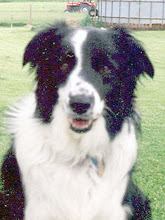Food or brood.
Last fall we debated what to do with a yearling ewe that had almost died a few months earlier.
On a July afternoon, I'd found the brown ewe standing by herself in the paddock. Head down, she was drooling. When asked to move, she was unsteady, especially on the left side. She'd gone blind in one eye.
A consultation with my sheep books gave me lists of possibilities: rabies, poisoning, a list of diseases. With no definitive answers and a concern it could spread to the rest of the flock, I called the vet.
"I've got a ewe exhibiting neurological symptoms," I said, and then went on to explain what I'd observed.
"I'm in the area, I'll stop by," he said.
When he arrived thirty minutes later, the ewe's temperature had spiked to 105 degrees and she was not moving.
With no obvious diagnosis, we threw everything at it: anti-inflammatories, antibiotics, b-complex vitamins, fluids. He also drew blood for testing if she should die.
My husband and I would give her three shots, twice a day, for the next five days.
For two days, she stood, head down, next to a stall wall.
"If she hasn't died yet, she'll live," a doctor friend and fellow sheep owner said.
On day four, she nibbled some hay.
My husband, who held a bowl of water to her lips several times a day, named her Fern.
Fern lived. In the coming weeks, she began eating and gained weight. Her gait improved. Her eyesight returned. By fall, she was fat; her coat, glossy.
I called the vet to report on her progress.
"What should we do with her?" I asked.
"You could use her for food and brood," he said.
Monday, June 10, 2013
Subscribe to:
Post Comments (Atom)













No comments:
Post a Comment